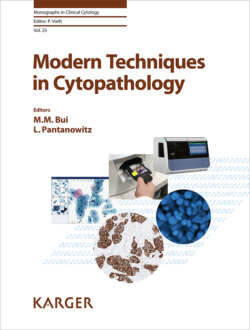Читать книгу Modern Techniques in Cytopathology - Группа авторов - Страница 25
На сайте Литреса книга снята с продажи.
Cell Blocks: Cellient Automated Cell Block System
ОглавлениеThe Cellient Automated Cell Block System (CACBS; Hologic, Marlborough, MA, USA), introduced in 2006 and built on existing ThinPrep (Hologic) liquid-based cytology, offers an alternative cell block process to overcome some of the shortcomings of traditional methods. Unlike other methods, the CACBS is not as operator dependent, thus providing greater consistency, uses vacuum-assisted filtration to capture all available cells, and employs paraffin as a medium to contain cells. With its many advantages, including automation and standardization, however, come significant associated capital, consumables, and operating costs relative to some of the other traditional methods (e.g., plasma-thrombin, HistoGel, and collodion bags) [21].
CACBS, consisting of two main components – the processor and the finishing station – assumes that some tasks are performed by technicians in the cytology and histology laboratories and yields a paraffin-embedded tissue block, rather than simply a cell pellet, as a final product. This is produced in a significantly shorter overall processing time: approximately 45 min compared to more than 2–8 h for other traditional cell blocks. CACBS accommodates preparing only one block at a time and does not allow for batch processing, so a high-volume laboratory may require multiple instruments.
There are preparatory steps that must take place before the specimen can be processed using CACBS. First, the sample is centrifuged and the supernatant is removed, similar to the traditional methods. An aliquot of the sample is then placed into PreservCyt (Hologic), an alcohol-based preservative. The processor automatically suctions the cells from the PreservCyt vial using vacuum assistance into a CACBS-specific tissue cassette with a detachable filter assembly [22]. Upon completion of the cell collection, the CACBS performs the steps of a tissue processor (e.g., dehydration, clearing, and paraffin infusion). Any tissue fragments in a sample must be manually placed into the cassette using a pipette or forceps by the operator rather than placing them into the processor.
Following paraffin infusion, the automated process cools and hardens the paraffin, after which the filter assembly is removed, leaving behind a circular cell-paraffin pellet attached to the outer surface of the cassette. Final steps occur in the finishing station, in which the cassette is placed into a paraffin-containing metal mold – one similar to that routinely used for embedding in histology laboratories. The CACBS indicates when the cassette is ready to be removed from the embedding mold for slide preparation.
